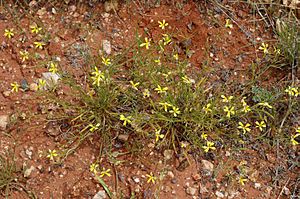Silky goodenia facts for kids
Quick facts for kids Silky goodenia |
|
|---|---|
 |
|
| Scientific classification | |
| Genus: |
Goodenia
|
| Species: |
fascicularis
|

The silky goodenia (scientific name: Goodenia fascicularis) is a beautiful flowering plant. It belongs to the Goodeniaceae plant family. You can find it growing across many parts of eastern Australia. This plant is a perennial herb, which means it lives for more than two years and has soft, green stems instead of woody ones. It has long, narrow or egg-shaped leaves and bright yellow flowers that grow in clusters.
Contents
What Does the Silky Goodenia Look Like?
The silky goodenia is a plant that grows upright. It usually reaches about 20 centimeters (about 8 inches) tall. Its leaves and stems are covered in fine hairs, making them feel "silky."
Leaves and Flowers
The leaves at the bottom of the plant are long and thin, or shaped like an egg. They can be from 20 to 140 millimeters long (about 1 to 5.5 inches) and 4 to 25 millimeters wide (about 0.15 to 1 inch). The leaves higher up on the stem are usually smaller.
The flowers are yellow and grow in leafy groups called racemes. These flower stalks can be up to 100 millimeters (about 4 inches) long. Each flower sits on a small stem called a peduncle, which is 20 to 70 millimeters long (about 0.8 to 2.7 inches).
The sepals, which are like small leaves protecting the flower bud, are shaped like a spear and are about 2.5 to 4 millimeters long. The yellow petals, called the corolla, are 12 to 23 millimeters long (about 0.5 to 0.9 inches). The lower part of the corolla is 5 to 10 millimeters long, and it has small "wings" that are about 1.2 to 2.5 millimeters wide.
Life Cycle and Fruit
Silky goodenia plants can flower almost any time of the year. After the flowers bloom, they produce a round fruit called a capsule. This capsule is about 5 to 8 millimeters (about 0.2 to 0.3 inches) across. It holds the plant's seeds.
Where Does the Silky Goodenia Grow?
This goodenia plant is very adaptable and can live in many different places. You might find it in scrublands, woodlands, and grasslands. In New South Wales, it grows west of the town of Tamworth. It also thrives in northern and north-western Victoria, and in the states of Queensland, the Northern Territory, and South Australia.
How Was It Named?
The silky goodenia was first officially described in 1890. Two important botanists, Ferdinand von Mueller and Ralph Tate, gave it its scientific name, Goodenia fascicularis. They wrote about it in a scientific publication called the Transactions, proceedings and report, Royal Society of South Australia. The plant samples they studied were collected in the Basedow Range, near a place called Imanpa in the Northern Territory. This happened during an exploration trip led by William Tietkens to Central Australia.
The second part of its scientific name, fascicularis, is a Latin word. It means "belonging to a small bundle," which might refer to how its leaves or flowers grow together.

